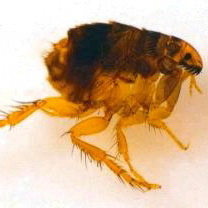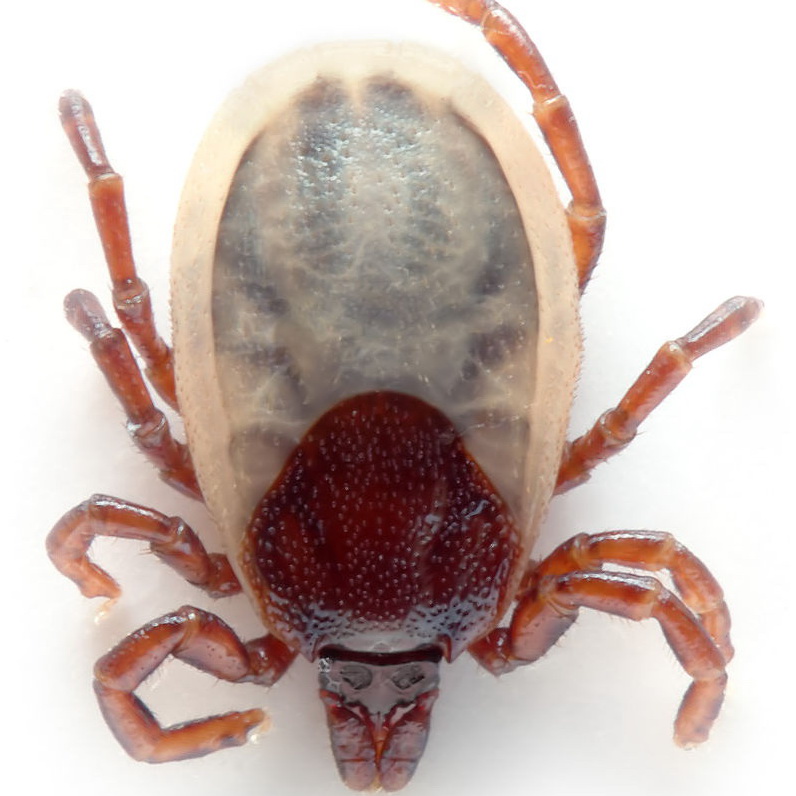GIARDIA
are unicellular organisms living in the intestine. They defecate infectous permanent forms, an infection of the surrounding occurs. The cysts are very resistant (in cold water or moist environment they stay infectous over months; but drought and heat let them die quickly).
Giardia cause persistent, varying, mucous diarrhoea, if the immune status is weakened it also may be bloody.
Highcarbohydrate diet supports the propagation, so adjust to easily digestible lowcarbohydrate diet!
The pathogen is treated with Metronidazol (Ipronidazol, Tinidazol, Carnidazol), the environment, the toilette, sleeping places must be cleaned with hot steam.
Giardia in dogs, cats and humans: On the way to the world supremacy?
Giardia and worms – danger for humans and animals
www.naturheilkunde-bei-tieren.de
COCCIDIA
are unicellular organisms, each individually drilling itself into a cell of the intestinal wall of their host and eating the content so that the cell dies. The unicellular organisms are very resistant, survive cold and common cleaning agents. Heat only beomes dangerous for them up from 55 degrees Celsius, that’s why in case of infection hot steam and boiling is recommended.
Cats may have avariety of coccidia f.e. isospora, sarcosporinia or toxoplasma gondii.
Isospora may be the cause for serious (possibly. bloody) diarrhoea, which if not treated may lead to dilution and dehydration and particularly for young or weak cats. at worst even may be fatal
This disease is treated with TSO, Kokzidiol, Metronidazol or Baycox 5%. Repeated thorough cleansing of sleeping places, bowls, transportation boxes, toilettes etc. with a steam jet is recommended!
SOURCES:
Combat of intestinal protozoea for dogs and cats
Small animal practice at the harbour
Intestinal parasites with dogs and cats
Toxoplasmosis is caused by the pathogen toxoplasma gondii, belonging to coccidia and therefore to protozoa. They are unicellular parasites reproducing carnally (inside the cat) and asexually (in intermediate hosts).
House cats and a few other cats (Lynx and wildcat in Europe) are the only final hosts of toxoplasma gondii.
T. gondii is very common world wide: 20-90% of the cats in middle europe are infected and nearly all sheep and goat grazing in germany. Indoor cats eating only boiled meat or canned food are infected less often. A cat probably stays infected for live but at least for 1.5 years. In those years excretion of oocysts can occur repeatedly. The cat is infected more likely by cysts from alternate hosts than by oocysts from the environment.
Nearly every warm-blooded animal like rodents, (feral) pigs, sheep, goats, horses, humans can be hosts, but also worms, snails, etc.
An infection with toxoplasmosis occurs unobtrusively in healthy living beings. Since hamsters and mice have a high susceptibility, the visibilty of the disease is more likely as well as with immunodeficient individuals, individuals having another infection (in humans for example AIDS) or individuals being treated with drugs (e.g. corticosteroids) or pregnant animals. Hormonal changes at the end of a pregnancy can trigger a new, recurring infection.
Symptoms of acute toxoplasmosis in cats can involve fever, diarrhea, inappetence and necrosis of organs. Necrosis occurs most frequently in the liver but also other organs as well as the placenta.
Sexual reproduction of t.gondii and therewith the excretion of the oocysts only occurs in cats. The oozcysts sporulate 2 to 4 days after the excretion and are highly infectious and resilient. In the envirmonment – with the right humidity – they stay infectious for more than a year, at +4°C for at least 3 weeks and at -18°C for about 3 days. Contact with not sporulated oozcysts and other developmental stages present in cats don’t lead to infection since they are highly sensitive to environmental influences.
Asexual reproduction in the tissue of alternate hosts and cats causes the formation of cycsts. These contain many infectious pathogens. They cause an infection in cats and in other alternate hosts, e.g. if an infected mouse is eaten by a cat or humans eat raw meat.
Initial infection of a mother during pregnancy causes an infection in 45-69% of the fetuses along with severe impaiments or miscarrige. The infection is caused by raw meat (also smear infections while preparing), natural milk or oocysten in cat’s dung.
Direct infection through secretion (rhinorrhoea, saliva) and excreta (urine) is not possible!
Oocysts in the environment stay infectious for about 5 years, at -18°C about 2 months, at +35°C about 5 weeks and at +55°C a few minutes.
Measurements
Tests:
Contrary to the still widely spread belief, it is not necessary to give away a cat due to a pregnancy!
In cats the most common worms are cestoda and nematoda.
In addition to the path of infection, the following transmission paths are distinguished:
· Infection through mouth or food (oral infection)
· Infection through the skin (percutan infection)
· Infection through the mother (intrauterine and lactogen infection)
Worm infections are differentiated by the infection with adult worms and the infection with their developmental stages. The first form of infection is more common in cats. Adverse effects are minor, only when infected to a greater degree lack of appetite, emaciation and ragged fur can occur due to the removal of nutrients. Parts of the worms, so called proglottids* leave the body through the anus and can cause iching and therefore sliding on the rear.
* The worm body is composed of a series of segments called proglottids, which are essentially packages of eggs. Proglottids leave the body through the anus and fall to the ground.
The period from infection to excretion of the infectious eggs is 2 to 12 weeks, depending on the species.
Praziquentel is used for prophylaxis and treatment.
The roundworms and hookworms are also Nematoda. The roundworm (Toxocara) has a different hatching process:
· Direct hatching in the stomach of the cat (rare)
· Hatching in the small bowel, migration through organs, via the trachea back in the gut -> worm
· Hatching in the gut, migration through the lungs into the muscels of the cat, encapsulation, reactivation by hormones during pregnancy -> lactogen infection
The period from infection to excretion of the infectious eggs is 3 to 10 weeks.
For the treatment of toxocara the following drugs are approved in Germany: Emodepsid, Fenbendazol, Flubendazol, Mebendazol, Milbemycinoxim, Moxidection, Pyrantel and Selamectin.
Hookworms are usually absorbed by ingestion (e.g. mice). The infection with hookworms often occurs unobtrusively. Only when infected to a greater degree emaciation, anaemia or diarrhoea can occur. The infection is proven by testing the dung for eggs via the flotation method.
The period from infection to excretion of the infectious eggs is 2,5 to 3 weeks.
For the teatment the same drugs as for roundworms are used.
Thermic therapy:
· Freezing is not suitable (please mind: frozen meat is no guarantee for being worm-free) since worm eggs and other steady stages are not killed.
· Exposure to 60°C to 100°C for a few minutes killes all vegetative stages of bacteria, viruses, fungus and oocycsten, eggs, trophozoites, cycsts etc of all parasites. Steam cleaners should be used!
against roundworms and hookworms
against tapeworms
against roundworms and hookworms and tapeworms
Stronghold / Selamectin(gegen Spul- und Herzwurm)
Banminth / Pyrantel (gegen Spul- und Hakenwürmer; auch bei tragenden und säugenden Kätzinnen einsetzbar)
Helmex / Pyrantel (gegen Spul- und Hakenwürmer; auch bei tragenden und säugenden Kätzinnen einsetzbar, stammt aus der Humanmedizin
Droncit / Praziquantel
Flubenol P / Flubendazol
Drontal / Praziquantel + Pyrantel (gegen Dipylidium, Taenia, Echnococcus, Toxocara, Ancylostoma; nicht bei tragenden Kätzinnen einsetzen!)
Milbemax / Milbemycin + Praziquantel (gegen Dipylidium, Taenia, Echnococcus, Toxocara, Ancylostoma; auch bei tragenden und säugenden Kätzinnen einsetzbar)
Profender Spot On / Praziquantel + Emodepsid (nicht unter 8 Wochen verabreichen! verursacht Haarverlust, Juckreiz, Entzündung an Applikationsstelle; auch bei tragenden und säugenden Kätzinnen einsetzbar)
Panacur Pet Paste /Fenbendazol (nur gegen Taenia u. Spul- u. Hakenwürmer)
Side effects of anthelminthis drugs (by manufacturers):
.
HINTERGRUNDINFORMATION ÜBER SPULWÜRMER

Fleas are an order in the class of insects and are parasites. They start breeding at a temperature of 5°C. Fleas can occur in stray cats and house cats (they are trasmitted by humans or other pets). About 5% of the population are grown fleas, the rest are developmental stages, they only infest cats for ingestion. Femals can only lay eggs after digesting blood (up to 5000).
Products/ methods to fight fleas:
· Flea Shampoo
· Flea collar (Serestro collar)
· Flea spray
· At the moment the most effective is Selamectin (Stronghold), Indoxacarb (Activyl, Imidacloprid/ Flumethrin)
· There is a high resistance rate with Fipronil (Fronline, Effipro)
· Bravecto for small dogs (no approval for cats yet)
· Tablets (Capstar)
· Spray (Virbac for the flat)
· Antiparasitic agent (Indorex duo-activ Fogger, Virbac)
Other measurements:
Ear mites are small, white parasites in the class of Arachnids. They live in the outer ear as well as the acoustic meatus of the cat and sting the skin to reach blood and lymph fluid. This causes intense itching. Often, they are not visible to the naked eye.
Typical symptoms are:
Ear mites are transmitted by other infected cats. They don’t infect humans.
If an inflammation occurs, gutter or body fluids can close the acoustic meatus completely, especially in young cats. Funghi and bacteria can spread unhindered.
After thorough cleaning of the ear, treatment is given by spreading ivermectin-containing ointment in the ear. The ears should be controlled regularly to prevent an outbreak.
Chewing lice are a subgroup of lice. They can occur on orifices (mouth, anus, vagina) of the cat. Chewing lice feed on skin scales and screts of small wounds. They cause severy ichting on the head, nack and back.
Mostly, cats are infected by other cats. Chewing lice donot infect humans. A severe infection can cause hairloss, inflammation and eczemas.
Typical symptoms are;
For prevention various spot-on products are available (with safety catch). An insecticidal powder (from the veterinarian) must be administered several times in about 10 days. The treatment must be repeated, since the eggs (nits) of the pathogen are not killed. If a cat is infected by chewing lite, if is recommended to also treat the near evironment, sleeping places and other cats.

Ticks are small parasites (arachnids), living by feeding on the blood of cats and other animals. Ticks lurk in meadows, parks, forests for their prey. The ticks crawl on the cat and pierce the skin. Depending on the species it takes 2 to 10 days until the tick is full of blood.
A safe protection agains ticks is not available, whether for humans nor animals. Prevention can only be achived by common flea-protective drugs, since the active substance permethrin, which is well active in dogs is harmful or letal for cats.
There are different tools to remove ticks:
· Tick remover: the tick is enfolded by the eyelet and pulled out of the wound with the narrow end. Easy to use.
· Insect tweezer: the tick is gripped at the head by the tweezer and pulled out of the skin. If applied correctly and with good visability very effective.
· Tick tong: easy to use, but the body of the tick is easily squished, leading to a higher risk of infection
We are an independent community of breeders and lovers of Thai cat at international level.